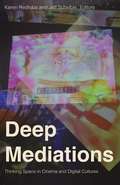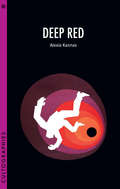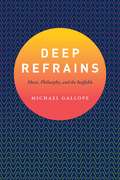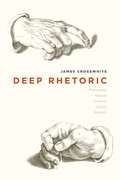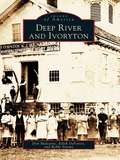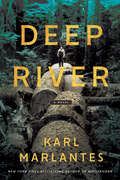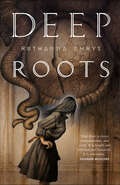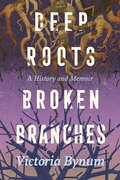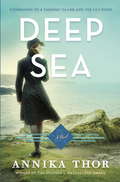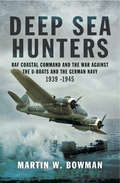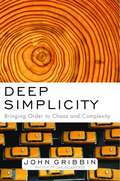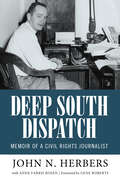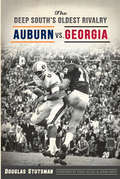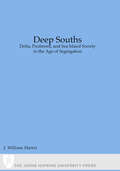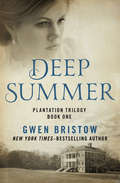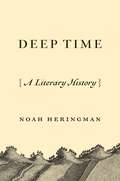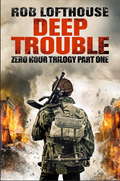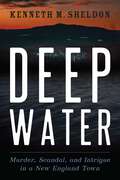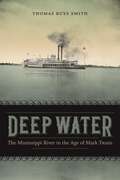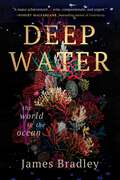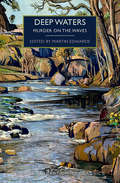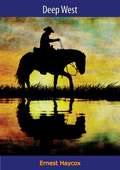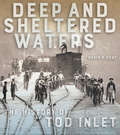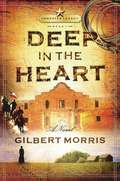- Table View
- List View
Deep Mediations: Thinking Space in Cinema and Digital Cultures
by Jeff Scheible Karen RedrobeThe preoccupation with &“depth&” and its relevance to cinema and media studiesFor decades the concept of depth has been central to critical thinking in numerous humanities-based disciplines, legitimizing certain modes of inquiry over others. Deep Mediations examines why and how this is, as scholars today navigate the legacy of depth models of thought and vision, particularly in light of the &“surface turn&” and as these models impinge on the realms of cinema and media studies.The collection&’s eighteen essays seek to understand the decisive but evolving fixation on depth by considering the term&’s use across a range of conversations as well as its status in relation to critical methodologies and the current mediascape. Engaging contemporary debates about new computing technologies, the environment, history, identity, affect, audio/visual culture, and the limits and politics of human perception, Deep Mediations is a timely interrogation of depth&’s ongoing importance within the humanities. Contributors: Laurel Ahnert; Taylor Arnold, U of Richmond; Erika Balsom, King&’s College London; Brooke Belisle, Stony Brook University; Jinhee Choi, King&’s College London; Jennifer Fay, Vanderbilt U; Lisa Han, UC Santa Barbara; Jean Ma, Stanford U; Shaka McGlotten, Purchase College-SUNY; Susanna Paasonen, U of Turku, Finland; Jussi Parikka, U of Southampton; Alessandra Raengo, Georgia State U; Pooja Rangan, Amherst College; Katherine Rochester, VIA Art Fund in Boston; Karl Schoonover, University of Warwick (UK); Jordan Schonig, Michigan State U; John Paul Stadler, North Carolina State U; Nicole Starosielski, New York U; Lauren Tilton, U of Richmond.
Deep Oakland: How Geology Shaped a City
by Andrew AldenA San Francisco Chronicle BestsellerRead the rocks as only a geologist can, with this deep drill-down into Oakland’s geological history and its impacts on the city’s urban present."This book has turned me into a newcomer to my own city, but has also changed the way I will view any landscape. I can think of few greater gifts than that."—Jenny Odell, author of How to Do Nothing"Spending time with Andrew Alden is like giving yourself x-ray eyes." —Roman Mars, host and creator of 99% InvisibleBeneath Oakland’s streets and underfoot of every scurrying creature atop them, rocks roil, shift, crash, and collide in an ever-churning seismological saga. Playing out since time immemorial, the deep geology of this city has chiseled and carved its landforms and the lives of everyone—from the Ohlone to the settlers to the transients and transplants—who has called this singular place home.In Deep Oakland, geologist Andrew Alden excavates the ancient story of Oakland’s geologic underbelly and reveals how its silt, soil, and subterranean sinews are intimately entwined with its human history—and future. Poised atop a world-famous fault line now slumbering, Alden charts how these quaking rocks gave rise to the hills and the flats; how ice-age sand dunes gave root to the city’s eponymous oak forests; how the Jurassic volcanoes of Leona Heights gave way to mining boom times; how Lake Merritt has swelled and disappeared a dozen times over the course of its million-year lifespan; and how each epochal shift has created the terrain cradling Oaklanders today. With Alden as our guide—and with illustrations by Laura Cunningham, author of A State of Change—we see that just as Oakland is a human crossroads, a convergence of cultures from the world over, so too is the bedrock below, carried here from parts still incompletely known.
Deep Red (Cultographies)
by Alexia KannasThe release of Italian director Dario Argento's Deep Red in 1975 saw both a return to form for the director and the crystallization of tropes of the giallo genre. While the film's immense popularity in Italy spawned a wave of copy-cat formula thrillers, this enthusiastic reception was not replicated by English-speaking audiences on its theatrical release. With its loosely woven narrative and hyper-stylized violent set pieces, Deep Red was critically panned in the United States and the UK as clichéd and exploitative Euro-schlock. Tracing the film's history of censorship, re-edited releases, and its subsequent celebration by cult film audiences, this book considers how these competing discourses have helped to transform the film's cultural status and to fashion it as an exemplar of cult cinema.
Deep Refrains: Music, Philosophy, and the Ineffable
by Michael GallopeWe often say that music is ineffable, that it does not refer to anything outside of itself. But if music, in all its sensuous flux, does not mean anything in particular, might it still have a special kind of philosophical significance? In Deep Refrains, Michael Gallope draws together the writings of Arthur Schopenhauer, Friedrich Nietzsche, Ernst Bloch, Theodor Adorno, Vladimir Jankélévitch, Gilles Deleuze, and Félix Guattari in order to revisit the age-old question of music’s ineffability from a modern perspective. For these nineteenth- and twentieth-century European philosophers, music’s ineffability is a complex phenomenon that engenders an intellectually productive sense of perplexity. Through careful examination of their historical contexts and philosophical orientations, close attention to their use of language, and new interpretations of musical compositions that proved influential for their work, Deep Refrains forges the first panoptic view of their writings on music. Gallope concludes that music’s ineffability is neither a conservative phenomenon nor a pious call to silence. Instead, these philosophers ask us to think through the ways in which music’s stunning force might address, in an ethical fashion, intricate philosophical questions specific to the modern world.
Deep Rhetoric: Philosophy, Reason, Violence, Justice, Wisdom
by James Crosswhite"Rhetoric is the counterpart of logic," claimed Aristotle. "Rhetoric is the first part of logic rightly understood," Martin Heidegger concurred. "Rhetoric is the universal form of human communication," opined Hans-Georg Gadamer. But in Deep Rhetoric, James Crosswhite offers a groundbreaking new conception of rhetoric, one that builds a definitive case for an understanding of the discipline as a philosophical enterprise beyond basic argumentation and is fully conversant with the advances of the New Rhetoric of Chaïm Perelman and Lucie Olbrechts-Tyteca. Chapter by chapter, Deep Rhetoric develops an understanding of rhetoric not only in its philosophical dimension but also as a means of guiding and conducting conflicts, achieving justice, and understanding the human condition. Along the way, Crosswhite restores the traditional dignity and importance of the discipline and illuminates the twentieth-century resurgence of rhetoric among philosophers, as well as the role that rhetoric can play in future discussions of ontology, epistemology, and ethics. At a time when the fields of philosophy and rhetoric have diverged, Crosswhite returns them to their common moorings and shows us an invigorating new way forward.
Deep River and Ivoryton (Images of America)
by Robbi Storms Don Malcarne Edith DeforestDeep River and Ivoryton, two villages in the lower Connecticut River Valley, were dominated for more than a century by "white gold"-ivory. The growth of the piano industry led to a new use for this exotic and long-treasured substance and, suddenly, the two villages became tied to Zanzibar, the most important exporting place for the tusks of African elephants.With more than two hundred exceptional photographs and narrative, Deep River and Ivoryton tells the story of how ivory shaped the economy and culture of these villages. Two companies, Pratt, Read & Company and the Comstock, Cheney & Company, employed thousands of people in satisfying the demand for new pianos. Probably more than ninety percent of the ivory processed in this country was handled in Deep River and Ivoryton. The demand for new instruments slowed with the invention of the radio, followed by the Great Depression of the 1930s, and the flow of material stopped altogether in the 1950s, when the use of ivory in the United States was banned.
Deep River: A Novel
by Karl MarlantesThree Finnish siblings head for the logging fields of nineteenth-century America in the New York Times–bestselling author’s “commanding historical epic” (Washington Post).Born into a farm family, the three Koski siblings—Ilmari, Matti, and Aino—are raised to maintain their grit and resiliency in the face of hardship. This lesson in sisu takes on special meaning when their father is arrested by imperial Russian authorities, never to be seen again. Lured by the prospects of the Homestead Act, Ilmari and Matti set sail for America, while young Aino, feeling betrayed and adrift after her Marxist cell is exposed, follows soon after.The brothers establish themselves among a logging community in southern Washington, not far from the Columbia River. In this New World, they each find themselves—Ilmari as the family’s spiritual rock; Matti as a fearless logger and entrepreneur; and Aino as a fiercely independent woman and union activist who is willing to make any sacrifice for the cause that sustains her.Layered with fascinating historical detail, this novel bears witness to the stump-ridden fields that the loggers—and the first waves of modernity—leave behind. At its heart, Deep River explores the place of the individual, and of the immigrant, in an America still in the process of defining its own identity.
Deep Roots (The Innsmouth Legacy #2)
by Ruthanna EmrysIn this dark fantasy sequel to Winter Tide, siblings in Cold War America look to rebuild their New England community only to find mystery and danger.A finalist for the Locus Award for Best Fantasy Novel and the Dragon Award for Best Fantasy NovelRuthanna Emrys’s Innsmouth Legacy, which began with Winter Tide and continues with Deep Roots, confronts H. P. Lovecraft’s Cthulhu Mythos head-on, boldly upturning his fear of the unknown with a heart-warming story of found family, acceptance, and perseverance in the face of human cruelty and the cosmic apathy of the universe. Emrys brings together a family of outsiders, bridging the gaps between the many people marginalized by the homogenizing pressure of 1940s America . . .Aphra Marsh, descendant of the People of the Water, has survived Deep One internment camps and made a grudging peace with the government that destroyed her home and exterminated her people on land. Deep Roots continues Aphra’s journey to rebuild her life and family on land, as she tracks down long-lost relatives. She must repopulate Innsmouth or risk seeing it torn down by greedy developers, but as she searches she discovers that people have been going missing. She will have to unravel the mystery, or risk seeing her way of life slip away.“Wicked for the Cthulhu Mythos.” —Seanan McGuire on the Innsmouth Legacy“Deep Roots is a marvel of a fantasy novel, with monsters fighting for their very existence and a place to call their own.” —Booklist“I really like this story and think fans of Lovecraft will enjoy it if they don’t mind switching genres. It’s not horror and it’s not a particularly “alien” version of the Mythos but it’s still a very good take on Lovecraft’s work which I enjoyed for its own sake.” —Grimdark Magazine
Deep Roots, Broken Branches: A History and Memoir (Willie Morris Books in Memoir and Biography)
by Victoria BynumBest known for her award-winning book The Free State of Jones: Mississippi’s Longest Civil War, historian Victoria Bynum turns now to her own history in this multigenerational American saga spanning from 1840 to 1979. Through meticulous historical research, personal letters, diaries, and the unpublished memoir of Mary Daniel Huckenpoehler, the author’s maternal grandmother, Bynum examines five generations within the broader context of the nation’s history, navigating pivotal events such as First Wave immigration, the Civil War, the Gilded Age, the Great Depression, two world wars, the Cold War, and beyond.Child of a mother from Waconia, Minnesota, and father from Jones County, Mississippi, Bynum blends a historian’s voice with personal experiences, intertwining her grandmother’s unpublished memoir and letters with her own role as a diarist and historian. She explores class, race, ethnicity, and gender dynamics. From the rise of Welsh immigrant ancestors in the Upper Midwest and the Gilded Age privileges of her grandmother’s upbringing to Bynum’s own tumultuous childhood in the 1950s and early 1960s as she is shuttled between Georgia, Mississippi, Minnesota, Florida, and California, Bynum grapples with numerous dangers of being raised in a volatile environment marked by alcohol-fueled violence, sexual degradation, and neglect. Against the backdrop of racial segregation, civil rights movements, and the Cold War, Deep Roots, Broken Branches traces the author’s coming-of-age journey, and the profound influence of her grandmother. Revealed through the lens and tensions of an Air Force family, Deep Roots, Broken Branches explores Bynum’s intellectual curiosity, voracious reading habits, and turbulent path through early motherhood, divorce, and higher education in California. Throughout, her grandmother remains a stabilizing force, offering inspiration and guidance. This book paints a vivid portrait of a southern identity’s growth amid personal challenges and broader societal shifts.
Deep Sea
by Annika Thor<P>Three years ago, Stephie and her younger sister, Nellie, escaped the Nazis in Vienna and fled to an island in Sweden, where they were taken in by different families. Now sixteen-year-old Stephie is going to school on the mainland. Stephie enjoys her studies, and rooming with her school friend, May. But life is only getting more complicated as she gets older. <P>Stephie might lose the grant money that is funding her education. Her old friend Verra is growing up too fast. And back on the island, Nellie wants to be adopted by her foster family. Stephie, on the other hand, can't stop thinking about her parents, who are in a Nazi camp in Austria. If only the war would end. . . . Like the deep sea, Stephie's life is filled with danger and darkness, but also with beauty and hope as she learns to stand up for her beliefs and be true to herself.
Deep Sea Hunters: RAF Coastal Command and the War Against the U-Boats and the German Navy 1939–1945
by Martin W. BowmanWith vivid firsthand accounts, this WWII history examines the RAF Coastal Command’s operations at sea against U-boats and the German Navy.In Deep Sea Hunters, historian Martin Bowman delves into the Royal Air Force Coastal Command’s dynamic role in countering German naval power during the Second World War. Beginning with the disastrous Norwegian Campaign, he covers the numerous attacks on the bustling German submarine base at Lorient, the attack on Brest, as well as many other pivotal and dramatic events of the conflict at sea. The hunt or U-boats is relayed in full and gripping detail, with first-hand accounts from U-boat attackers—as well as German submariners—punctuating Bowman’s dramatic prose. This two-sided history is sure to appeal to all enthusiasts interested in gaining a balanced insight into Second World War naval history.
Deep Simplicity: Bringing Order to Chaos and Complexity
by John GribbinOver the past two decades, no field of scientific inquiry has had a more striking impact across a wide array of disciplines–from biology to physics, computing to meteorology–than that known as chaos and complexity, the study of complex systems. Now astrophysicist John Gribbin draws on his expertise to explore, in prose that communicates not only the wonder but the substance of cutting-edge science, the principles behind chaos and complexity. He reveals the remarkable ways these two revolutionary theories have been applied over the last twenty years to explain all sorts of phenomena–from weather patterns to mass extinctions. <p><p> Grounding these paradigm-shifting ideas in their historical context, Gribbin also traces their development from Newton to Darwin to Lorenz, Prigogine, and Lovelock, demonstrating how–far from overturning all that has gone before–chaos and complexity are the triumphant extensions of simple scientific laws. Ultimately, Gribbin illustrates how chaos and complexity permeate the universe on every scale, governing the evolution of life and galaxies alike.
Deep South Dispatch: Memoir of a Civil Rights Journalist (Willie Morris Books in Memoir and Biography)
by John N. HerbersFormer New York Times correspondent John N. Herbers (1923-2017), who covered the civil rights movement for more than a decade, has produced Deep South Dispatch: Memoir of a Civil Rights Journalist, a compelling story of national and historical significance. Born in the South during a time of entrenched racial segregation, Herbers witnessed a succession of landmark civil rights uprisings that rocked the country, the world, and his own conscience. Herbers's retrospective is a timely and critical illumination on America's current racial dilemmas and ongoing quest for justice.Herbers's reporting began in 1951, when he covered the brutal execution of Willie McGee, a black man convicted for the rape of a white housewife, and the 1955 trial for the murder of Emmett Till, a black teenager killed for allegedly whistling at a white woman. With immediacy and first-hand detail, Herbers describes the assassination of John F. Kennedy; the death of four black girls in the Birmingham, Alabama, church bombing; extensive travels and interviews with Martin Luther King Jr.; Ku Klux Klan cross-burning rallies and private meetings; the Freedom Summer murders in Philadelphia, Mississippi; and marches and riots in St. Augustine, Florida, and Selma, Alabama, that led to passage of national civil rights legislation.This account is also a personal journey as Herbers witnessed the movement with the conflicted eyes of a man dedicated to his southern heritage but who also rejected the prescribed laws and mores of a prejudiced society. His story provides a complex understanding of how the southern status quo, in which the white establishment benefited at the expense of African Americans, was transformed by a national outcry for justice.
Deep South's Oldest Rivalry, The: Auburn vs. Georgia (Sports)
by Douglas StutsmanThe rivalry between Auburn University and the University of Georgia began in 1892 and has largely been a competition more brotherly than bitter. According to one legend, Auburn’s “War Eagle” battle cry originated at the first game between the two schools. The first overtime game in SEC history occurred in 1996, when Georgia topped the heavily favored Tigers, 56–49, in four extra periods. Renowned UGA coach Vince Dooley graduated from Auburn, while Auburn coach Pat Dye was an All-American at UGA. Join award-winning journalist Doug Stutsman as he recounts the unforgettable games, moments and personalities on the 125th anniversary of the Deep South’s Oldest Rivalry.
Deep Souths: Delta, Piedmont, and Sea Island Society in the Age of Segregation
by J. William HarrisFinalist for the Pulitzer Prize in HistoryCo-winner of the James A. Rawley Prize from the Organization of American HistoriansWinner of the Theodore Saloutos Memorial Book Prize from the Agricultural History SocietyDeep Souths tells the stories of three southern regions from Reconstruction to World War II: the Mississippi-Yazoo Delta, the eastern Piedmont of Georgia, and the Georgia Sea Islands and Atlantic coast. Though these regions initially shared the histories and populations we associate with the idea of a "Deep South"—all had economies based on slave plantation labor in 1860—their histories diverged sharply during the three generations after Reconstruction. With research gathered from oral histories, census reports, and a wide variety of other sources, Harris traces these regional changes in cumulative stories of individuals across the social spectrum. Deep Souths presents a comparative and ground-level view of history that challenges the idea that the lower South was either uniform or static in the era of segregation. By the end of the New Deal era, changes in these regions had prepared the way for the civil rights movement and the end of segregation.
Deep Summer: Deep Summer, The Handsome Road, And This Side Of Glory (Plantation Trilogy #1)
by Gwen BristowThe New York Times–bestselling author of Jubilee Trail does &“a grand job of storytelling&” in this saga of pioneers who settled the Louisiana wilderness (The New York Times). For his service in the king&’s army during the French and Indian War, Judith Sheramy&’s father, a Puritan New Englander, is granted a parcel of land in far-off Louisiana. As the family ventures down the Mississippi to make a new home in the wilderness, Judith meets Philip Larne, an adventurer who travels in the finest clothes Judith has ever seen. He is a rogue, a killer, and a thief—and the first thing he steals is Judith&’s heart. Three thousand acres of untamed jungle, populated by native tribes and overrun with jaguars and pirates, await Philip in Louisiana. He and Judith will struggle through their stormy marriage and the challenges of the American Revolution as they strive to build an empire for future generations. This is the first novel in Gwen Bristow&’s Plantation Trilogy, which also includes The Handsome Road and This Side of Glory.
Deep Time: A Literary History
by Noah HeringmanHow the concept of “deep time” began as a metaphor used by philosophers, poets, and naturalists in the eighteenth and nineteenth centuriesIn this interdisciplinary book, Noah Heringman argues that the concept of “deep time”—most often associated with geological epochs—began as a metaphorical language used by philosophers, poets, and naturalists of the eighteenth and nineteenth centuries to explore the origins of life beyond the written record. Their ideas about “the abyss of time” created a way to think about the prehistoric before it was possible to assign dates to the fossil record. Heringman, examining stories about the deep past by visionary thinkers ranging from William Blake to Charles Darwin, challenges the conventional wisdom that the idea of deep time came forth fully formed from the modern science of geology. Instead, he argues, it has a rich imaginative history.Heringman considers Johann Reinhold Forster and Georg Forster, naturalists on James Cook’s second voyage around the world, who, inspired by encounters with Pacific islanders, connected the scale of geological time to human origins and cultural evolution; Georges-Louis Leclerc, Comte de Buffon, who drew on travel narrative, antiquarian works, and his own fieldwork to lay out the first modern geological timescale; Blake and Johann Gottfried Herder, who used the language of fossils and artifacts to promote ancient ballads and “prehistoric song”; and Darwin’s exploration of the reciprocal effects of geological and human time. Deep time, Heringman shows, has figural and imaginative dimensions beyond its geological meaning.
Deep Trouble: (1)
by Rob LofthouseWritten by a retired British soldier, Deep Trouble is the first in a trilogy of novels telling the breathless, vivid story of one young recruit's experience of one of the greatest military invasions ever launched.6 June 1944 - Somewhere over the Normandy coastline, Robbie Stokes sits in a glider, his Bren resting on the floor between his outstretched legs. The nose lowers and the glider descends rapidly: ten minutes of stomach-churning twists and turns until suddenly the call goes up to 'BRACE'. The belly makes contact with the ground and the first Allied troops tumble out into occupied Europe.For Robbie Stokes it is the beginning of 72 hours of brutal and relentless conflict: a test of character, a test of nerve, a test of comradeship, of the band of brothers around him. If they fail, then the Allied invasion fails. They must succeed on their longest day.The operation to Pegasus Bridge is one of the most famous of the Second World War. Taking place six hours before the famous Normandy landings, when six gliders deposited the 2nd Battalion, Oxford and Bucks Light Infantry behind enemy lines with the orders to take and hold the bridges at Bénouville and Ranville.Part of this work has been previously published under the title, Well Past Trouble.
Deep Water: Murder, Scandal, and Intrigue in a New England Town
by Kenneth M. SheldonIn the waning days of World War I, William K. Dean was brutally murdered, his body hog-tied and dumped in a rainwater cistern on his farm in the quiet town of Jaffrey, New Hampshire. Suspicion quickly fell on Dean's wife, an invalid in the early stages of dementia. Her friends, outraged at the accusations, pointed instead to a former tenant of Dean&’s, whom many suspected of being a German spy. Others believed that Dean's best friend, a politically powerful banker and judge, was involved.Deep Water is based on extensive research into the Dean murder, including thousands of pages of FBI documents, Grand Jury testimonies, newspaper accounts, private correspondence, and the archives of the Jaffrey Historical Society.
Deep Water: The Mississippi River in the Age of Mark Twain (Southern Literary Studies)
by Thomas Ruys SmithMark Twain’s visions of the Mississippi River offer some of the most indelible images in American literature: Huck and Jim floating downstream on their raft, Tom Sawyer and friends becoming pirates on Jackson’s Island, the young Sam Clemens himself at the wheel of a steamboat. Through Twain’s iconic river books, the Mississippi has become an imagined river as much as a real one. Yet despite the central place that Twain’s river occupies in the national imaginary, until now no work has explored the shifting meaning of this crucial connection in a single volume. Thomas Ruys Smith’s Deep Water: The Mississippi River in the Age of Mark Twain is the first book to provide a comprehensive narrative account of Twain’s intimate and long-lasting creative engagement with the Mississippi. This expansive study traces two separate but richly intertwined stories of the river as America moved from the aftermath of the Civil War toward modernity. It follows Twain’s remarkable connection to the Mississippi, from his early years on the river as a steamboat pilot, through his most significant literary statements, to his final reflections on the crooked stream that wound its way through his life and imagination. Alongside Twain’s evolving relationship to the river, Deep Water details the thriving cultural life of the Mississippi in this period—from roustabouts to canoeists, from books for boys to blues songs—and highlights a diverse collection of voices each telling their own story of the river. Smith weaves together these perspectives, putting Twain and his creations in conversation with a dynamic cast of river characters who helped transform the Mississippi into a vibrant American icon.By balancing evocative cultural history with thought-provoking discussions of some of Twain’s most important and beloved works, Deep Water gives readers a new sense of both the Mississippi and the remarkable writer who made the river his own.
Deep Water: The World in the Ocean
by James Bradley"Deep Water is a major achievement....Bradley's skills both as novelist and essayist converge here to create this wise, compassionate and urgent book, characterized throughout by a clarity of prose and a bracing moral gaze that searches water, self and reader." —ROBERT MACFARLANE, bestselling author of UnderlandIn this thrilling work—a blend of history, science, nature writing, and environmentalism—acclaimed writer James Bradley plunges into the unknown to explore the deepest recesses of the natural world.Seventy-one percent of the earth’s surface is ocean. These waters created, shaped, and continue to sustain not just human life, but all life on Planet Earth, and perhaps beyond it. They serve as the stage for our cultural history—driving human development from evolution through exploration, colonialism, and the modern era of global leisure and trade. They are also the harbingers of the future—much of life on Earth cannot survive if sea levels are too low or too high, temperatures too cold or too warm. Our oceans are vast spaces of immense wonder and beauty, and our relationship to them is innate and awe inspired.Deep Water is both a lyrically written personal meditation and an intriguing wide-ranging reported epic that reckons with our complex connection to the seas. It is a story shaped by tidal movements and deep currents, lit by the insights of philosophers, scientists, artists and other great minds. Bradley takes readers from the atomic creation of the oceans, to the wonders within, such as fish migrations guided by electromagnetic sensing. He describes the impacts of human population shifts by boat and speaks directly and uncompromisingly to the environmental catastrophe that is already impacting our lives. It is also a celebration of the ocean’s glories and the extraordinary efforts of the scientists and researchers who are unlocking its secrets. These myriad strands are woven together into a tapestry of life that captures not only our relationship with the planet, but our past, and perhaps most importantly, what lies ahead for us.A brilliant blend of Robert MacFarlane’s Underland, Susan Casey’s The Underworld, and Simon Winchester’s Pacific and The Atlantic, Deep Water taps into the essence of our planet and who we are.
Deep Waters: Murder On The Waves (British Library Crime Classics)
by Martin EdwardsMystery crime fiction written in the Golden Age of MurderFrom picturesque canals to the swirling currents of the ocean, a world of secrets lies buried beneath the surface of the water. Dubious vessels crawl along riverbeds, while the murky depths conceal more than one gruesome murder.The stories in this collection will dredge up delight in crime fiction fans, as watery graves claim unintended dwellers and disembodied whispers penetrate the sleeping quarters of a ship's captain. How might a thief plot their escape from a floating crime scene? And what is to follow when murder victims, lost to the ocean floor, inevitably resurface?This British Library anthology uncovers the best mysteries set below the surface, including stories by Arthur Conan Doyle, William Hope Hodgson, and R. Austin Freeman.
Deep West
by Ernest HaycoxJUSTICE IS DEALT THE WINNING HANDA steer should only have one brand. When it’s got two, that’s rustlin’. And rustlin’ is the biggest kind of trouble round about Granite Canyon...unless you’re talking dead!When a range detective from the Cattleman’s Association turns up slung across the back of his horse like a piece of dead meat with a couple of bullet holes in him, Jim Benbow figures he’s got trouble. Benbow reckons Cash Gore is behind both the rustlin’ and the murder. And rumor has it that Benbow’s friend Clay Brand is working for Gore. But friend or not, no one cheats Benbow of The Hat. If any sidewinder tries it, he’ll get justice from a bullet or a hangman’s knot.Benbow knows he can finger the gunhands...but time is running out. A showdown is inevitable and when it comes, the renegades will feel the cold fury of lawfulness from a man marked for death!
Deep and Sheltered Waters: The History of Tod Inlet
by David R. GrayA vivid social history of a remarkable place, drawing on research as deep as the waters themselves.This book brings to light the fascinating story of a community and place: Tod Inlet, near Victoria, BC. From the original inhabitants from the Tsartlip First Nation to the lost community of immigrant workers from China and India, from a company town to the development of parkland, the wealth of history in this rich area reflects much of the history of the entire province. The story of Tod Inlet and its communities spans from Vancouver Island to the BC coast north to Ocean Falls, south to California, and east to Golden, BC.David Gray draws from from interviews with elders of the Tsartlip First Nation, descendants of the Chinese and Sikh workers, and the local community, and from archives held in Victoria and Ottawa. This detailed, illustrated book by an award-winning filmmaker tells the whole story of the natural area, the archaeological sites, the community of Tod Inlet, the Vancouver Portland Cement Company and cement plant (an industrial first), and the development of the Butchart Gardens.
Deep in the Heart (Lone Star Legacy #1)
by Gilbert MorrisThey came to Texas to make their family whole. They fought for the land they'd come to love. An unforgettable saga of faith, love and loyalty that will find its place deep in your heart.<P> In the days when Texas was the northern edge of Mexico, when Bowie and Houston and Crockett were men and not yet legends, when the Alamo was still a scruffy mission on the banks of the San Antonio River, this unorthodox family struggled to make a wild but beautiful land their own.<P> This is the tale of Jerusalem Ann, who is willing to take whatever life dishes out in order to make a life for her family. It's the story of Clay, who finds himself protecting another man's family - and in love with another man's wife. It's about Jake, who loves two women and can't do right by either... and Julie, who'd rather be free than respectable... and Bowie, who can handle war but might not survive his first love. It's the story of Comanches and fiestas, hunting parties and courting parties, of battles and massacres and beautiful calm nights under a canopy of stars.<P> Wide as the prairies, warm as a San Antonia breeze, spiced with adventure and romance, this Texas-sized saga of faith from a beloved storyteller will quickly find its place deep in your heart.. and never let you go.
